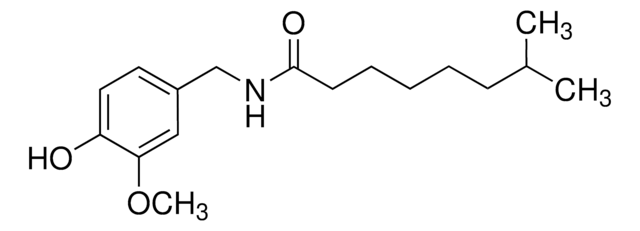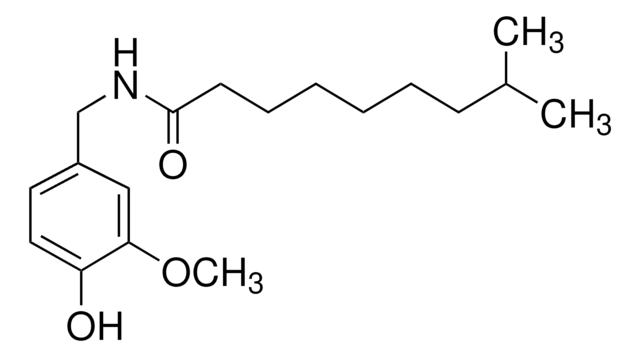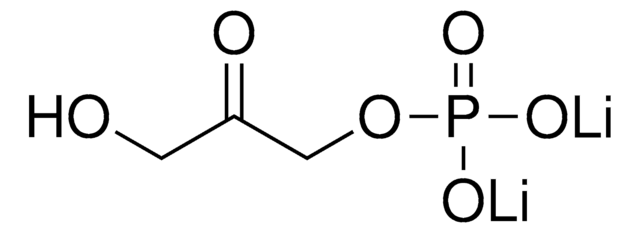Y0000671
Capsaicin
European Pharmacopoeia (EP) Reference Standard
동의어(들):
8-Methyl-N-vanillyl-trans-6-nonenamide
로그인조직 및 계약 가격 보기
모든 사진(1)
About This Item
Linear Formula:
(CH3)2CHCH=CH(CH2)4CONHCH2C6H3-4-(OH)-3-(OCH3)
CAS Number:
Molecular Weight:
305.41
Beilstein:
2816484
EC Number:
MDL number:
UNSPSC 코드:
41116107
PubChem Substance ID:
NACRES:
NA.24
추천 제품
Grade
pharmaceutical primary standard
Agency
EP Reference Standard
API family
capsaicin
제조업체/상표
EDQM
mp
62-65 °C (lit.)
응용 분야
pharmaceutical (small molecule)
형식
neat
저장 온도
2-8°C
SMILES string
COc1cc(CNC(=O)CCCC\C=C\C(C)C)ccc1O
InChI
1S/C18H27NO3/c1-14(2)8-6-4-5-7-9-18(21)19-13-15-10-11-16(20)17(12-15)22-3/h6,8,10-12,14,20H,4-5,7,9,13H2,1-3H3,(H,19,21)/b8-6+
InChI key
YKPUWZUDDOIDPM-SOFGYWHQSA-N
유전자 정보
human ... TRPV1(7442)
유사한 제품을 찾으십니까? 방문 제품 비교 안내
일반 설명
This product is provided as delivered and specified by the issuing Pharmacopoeia. All information provided in support of this product, including SDS and any product information leaflets have been developed and issued under the Authority of the Issuing Pharmacopoeia. For further information and support please go to the website of the issuing Pharmacopoeia.
애플리케이션
Capsaicin EP Reference standard, intended for use in laboratory tests only as specifically prescribed in the European Pharmacopoeia.
생화학적/생리학적 작용
Prototype vanilloid receptor agonist. Neurotoxin; activates sensory neurons that give rise to unmyelinated C-fibers, many of which contain substance P. Topical application desensitizes the sensory nerve endings giving a paradoxical antinociceptive effect; systemic administration can be neurotoxic to capsaicin-sensitive cells, especially in newborn animals. Active component of chili peppers.
포장
The product is delivered as supplied by the issuing Pharmacopoeia. For the current unit quantity, please visit the EDQM reference substance catalogue.
기타 정보
Sales restrictions may apply.
신호어
Danger
유해 및 위험 성명서
Hazard Classifications
Acute Tox. 2 Oral - Eye Dam. 1 - Resp. Sens. 1 - Skin Irrit. 2 - Skin Sens. 1 - STOT SE 3
표적 기관
Respiratory system
Storage Class Code
6.1A - Combustible acute toxic Cat. 1 and 2 / very toxic hazardous materials
WGK
WGK 3
Flash Point (°F)
235.4 °F - closed cup
Flash Point (°C)
113 °C - closed cup
가장 최신 버전 중 하나를 선택하세요:
이미 열람한 고객
Jennifer Leech et al.
American journal of respiratory and critical care medicine, 188(9), 1069-1075 (2013-10-08)
Antitussive therapies are accompanied by a substantial placebo effect, indicating that inhibitory circuits in the brain have a significant capacity to regulate cough neural processing. However, essentially nothing is known about the identity of these inhibitory circuits or how they
Zohar Bromberg et al.
PloS one, 8(2), e57149-e57149 (2013-03-08)
The heat shock response (HSR) is a highly conserved molecular response to various types of stresses, including heat shock, during which heat-shock proteins (Hsps) are produced to prevent and repair damages in labile proteins and membranes. In cells, protein unfolding
Emma C Y Hilton et al.
The Journal of allergy and clinical immunology, 132(4), 847-855 (2013-06-20)
Inhaled capsaicin elicits cough reproducibly in human subjects and is widely used in the study of cough and antitussive therapies. However, the traditional end points C2 and C5 (the concentrations of capsaicin inducing at least 2 or 5 coughs, respectively)
Helen Sumner et al.
American journal of respiratory and critical care medicine, 187(9), 943-949 (2013-03-09)
Cough is one of the principal symptoms of chronic obstructive pulmonary disease (COPD) but the potential drivers of cough are likely to be multifactorial and poorly understood. To quantify cough frequency in an unselected group of subjects with COPD and
Jessica O'Neill et al.
Pharmacological reviews, 64(4), 939-971 (2012-10-02)
A large number of pharmacological studies have used capsaicin as a tool to activate many physiological systems, with an emphasis on pain research but also including functions such as the cardiovascular system, the respiratory system, and the urinary tract. Understanding
자사의 과학자팀은 생명 과학, 재료 과학, 화학 합성, 크로마토그래피, 분석 및 기타 많은 영역을 포함한 모든 과학 분야에 경험이 있습니다..
고객지원팀으로 연락바랍니다.









